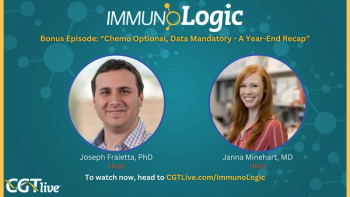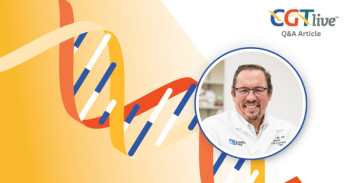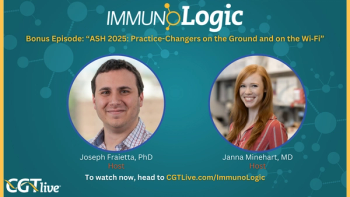
Gavo-cel Shows Promise for Mesothelin-Expressing Solid Tumors, Set to Proceed to Phase 2
TCR2 Therapeutics’ T cell therapy gavocabtagene autoleucel showed encouraging antitumor activity in the phase 1 portion of an ongoing trial, with an identified recommended dose for the next phase.
Recently published results in Nature Medicine from the ongoing open-label, first-in-human, multicenter phase 1/2 trial (NCT03907852) of gavocabtagene autoleucel (gavo-cel; TCR2 Therapeutics) showed an overall response rate of 20% (13% confirmed partial response) and a disease control rate of 77% in a population of 30 evaluable patients with treatment-refractory mesothelin-expressing solid tumors.1
The 6-month overall survival rate was 70%. All told, the investigators noted that these preliminary data support the continuation to the phase 2 portion of the study in mesothelin-expressing cancers.
“Our data strongly support the development of [T-cell receptor fusion construct]-based cell therapies in patients with solid tumors as well as mesothelin as a target,” first author Raffit Hassan, MD, senior investigator in the Throracic and GI Malignancies Branch of the National Cancer Institute Center for Cancer Research, and colleagues wrote. “Given the promising preliminary results reported here, a phase 2 study is underway to evaluate the efficacy of gavo-cel in mesothelin-expressing cancers, which will allow for repeat intravenous dosing and the combination with [immune-checkpoint inhibition] therapy as strategies to promote greater gavo-cel exposure and to prevent exhaustion of the engineered T cells.”
READ MORE:
In total, the trial includes 32 patients with a median age of 63 years (range, 28-84; 12 men, 20 women) with diagnoses of mesothelioma (n = 23), ovarian cancer (n = 8), and cholangiocarcinoma (n = 1), of whom 30 were included as responders for this analysis. Gavo-cel was infused at different dose levels either as a single agent or after lymphodepletion (LD) with fludarabine and cyclophosphamide. The dose levels included the following:
- Dose level 0: 5×107 cells/m2 without LD (n = 1)
- Dose level 1: 5×107 cells/m2 (n = 8)
- Dose level 2: 1×108 cells/m2 without LD (n = 1)
- Dose level 3: 1×108 cells/m2 (n = 13)
- Dose level 3.5: 3×108 cells/m2, as a split dose of 1×108 and 2×108 cells on days 0 and 3 (n = 5)
- Dose level 4: 5×108 cells/m2 without LD (n = 1)
- Dose level 4.5: 5×108 cells/m2 (n = 3)
The study’s primary end point was safety through the 28-day mark post infusion. At that time, all treatment-related adverse events (AEs) reported in at least 10% of patients included pyrexia, fatigue, peripheral edema, CRS, nausea, diarrhea, constipation, abdominal pain, vomiting, dyspnea, hypoxia, pleural effusion, cough, pneumonitis, anemia, febrile neutropenia, neutropenia, leukopenia, lymphopenia, thrombocytopenia, hypotension, deep vein thrombosis, pneumonia, urinary tract infection, headache, dizziness, alopecia, tachycardia, anxiety, alanine aminotransferase increase, weight loss, blood fibrinogen decrease, hypoalbuminemia, hyponatremia, hypomagnesemia, hypokalemia, and hypophosphatemia.
The most frequently occurring AEs of grade 3 or higher, though, were cytopenias related to lymphodepleting chemotherapy—this included 91% of patients with neutropenia, 97% with lymphopenia, and 22% with thrombocytopenia—all of which were reversible. The on-target/off-tumor toxicities that were observed were pleuritis (grade 3, n = 2) at dose level 3 and dose level 3.5, pericarditis (grade 3, n = 1) at dose level 3.5, and peritonitis (grade 3, n = 1) at dose level 3.
Hassan and colleagues acknowledged that while the antitumor activity is promising, gavo-cel may have a narrow therapeutic window that could limit its use, along with a clear need to monitor patients for cytokine release syndrome (CRS) or pneumonitis. Notably, the data show a trend toward dose-dependency regarding the incidence, severity, and onset of the former—every patient at dose level 5 reported a grade 3 or higher CRS within the first 24 hours of infusion. The study’s safety review team recommended a halt of dose escalation to this level and deescalated these patients to dose level 3.5 on the third day after LD; despite this, 3 of the 5 patients in question developed grade 3 or higher pneumonitis, at which time the safety team declared dose level 2 as the recommended phase 2 dose (RP2D).
“Although, numerically speaking, the dose differential between [dose level 3] and [dose level 3.5] appears moderate, the toxicity profiles observed at each of these [dose levels] were markedly different in terms of the frequency and severity of both pneumonitis and CRS. No cases of pneumonitis were reported at the RP2D, and only 2 patients developed severe CRS, which was rapidly reversible in both cases,” Hassan et al wrote.
Gavo-cel, previously known as TC-210, is a TRuC that is a result of a fusion of a humanized llama-derived, single-domain antimesothelin antibody MH1 to a 15-aminoacid flexible glycine/serine spacer and the human CD3ε subunit. This TRuC is then cloned, transduced into T cells, and integrated into native CD3 complexes, which it reprograms to activate upon tumor cell surface mesothelin recognition, independent of human leukocyte antigen.
The overall response rate, according to Response Evaluation Criteria in Solid Tumors (RECIST) version 1.1, was 20% (intent-to-treat [ITT] population, 12.5%). This included 6 patients (malignant pleural or peritoneal mesothelioma, n = 4; ovarian cancer, n = 2), and of those individuals, 4 had a confirmed partial response (13%; mesothelioma, n = 2; ovarian cancer, n = 2). Per the local investigator assessment, the overall response rate was 23% (ITT population, 15%), including 1 additional patient with cholangiocarcinoma who was also deemed to have achieved a partial response. A gradual response was shown in another 1 patient with mesothelioma, with a regression of target lesions less than 30% at 3 months—this patients’ 6-month CT scan showed target lesion tumor regression of more than 30%, but a new lesion was identified.
By both blinded independent central review and local investigator assessment, the overall response rate was 22% and 26%, respectively, among patients who received gavo-cel after LD. Median time to response was 1.15 months (95% CI, 0.76-1.53), whereas the median duration of response was 4.6 months (95% CI, 1.77-7.42).
Median progression-free survival and overall survival for all patients was 5.6 months (95% CI, 3.1-5.8) and 10.6 months (95% CI, 6.6-15.6), respectively. The 6-month overall survival rate was 70.2%. For patients with mesothelioma receiving gavo-cel after LD, the overall response rate was 21%; for patients with ovarian cancer, that rate was 29%.
REFERENCE
1. Hassan R, Butler M, O’Cearbhaill RE, et al. Mesothelin-targeting T cell receptor fusion construct cell therapy in refractory solid tumors: phase 1/2 trial interim results. Nat Med. Published online July 27, 2023. doi:10.1038/s41591-023-02452-y
Newsletter
Stay at the forefront of cutting-edge science with CGT—your direct line to expert insights, breakthrough data, and real-time coverage of the latest advancements in cell and gene therapy.





































